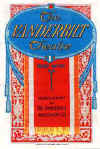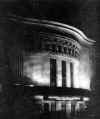Demolished Broadway Theatres - T to Z
Compiled by John Kenrick
(Copyright 2009)
(The images below are thumbnails – click on them to see larger versions.)
- Tammany
- Thalia
- Theatre Comique (1st)
- Theatre Comique (2nd)
- Thirty-Ninth Street
- Tripler Hall
- Union Square
- Vanderbilt
- Venice
- Waldorf
- Wallack's (1st)
- Wallack's (2nd)
- Waverly
- Weber and Fields Music Hall
- Windsor (Bowery - Downtown)
- Windsor (48th Street - Midtown)
- Winter Garden (Old)
- Wood's Minstrel Hall
- Wood's Museum
- Ziegfeld
Tammany
North Side of 14th Street, East of Broadway
Built: 1867
This auditorium was housed in the headquarters of New York's infamous
political machine, Tammany Hall. It held legitimate productions from
1869 to 1876.
Thalia
- see The Bowery
Theatre Comique (1st - 514 Broadway)
- see Wood's Minstrel Hall
Theatre Comique (2nd)
728 Broadway (Opposite Waverly Place)
Built: 1865
Demolished: 1884 (fire)
Other names: Lucy Rushton's New York Theatre
History: This was a Unitarian Church until department store owner
A.T. Stewart converted it into a theatre for actress Lucy Rushton in
1865. It was here in 1866 that The Black Domino and Between
You, Me and the Post became the first Broadway productions to bill
themselves as "musical comedies." Considered haunted by its
religious past, this house fell into disuse use until Harrigan and Hart
refurbished it and renamed it Theatre Comique
in 1881. It was destroyed by fire three years later.
Thirty Ninth Street Theatre
- see Nazimova's
Tripler Hall
- see Winter Garden (Old)
Union Square Theatre
Broadway and Fourth Avenue
Built: 1870
Demolished: 1936
Also Named: Acme
Owners: Sheridan Shook, Albert Palmer (1872-1883), Keith and
Albee (1873-1914).
History: Built for variety shows, the Union Square switched to legit
bookings in 1872. In 1883, Keith and Albee added it to their growing
vaudeville circuit -- the Four Cohans made their Manhattan debut on the
opening bill. A movie house from 1914 on, it was renamed the Acme in
1921 and served as a home for Soviet Russian films.
 Vanderbilt
Vanderbilt
148 West 48th Street
Built: 1918
Demolished: 1954
Seats: 798
Architect: Eugene DeRosa
Owners: Lyle Andrews (1918-1935)
History: A favorite house for intimate musicals and plays in the
1920s, the Vanderbilt became a radio studio in the 1930s and 40s. It was
demolished after a series of flops in the early 1950s. The parking garage that
replaced it was designed by theatre architect Herbert J.
Krapp.
Musicals: Oh Look (1919), Irene (1919), The Girl
Friend (1926), Peggy Ann (1926), A Connecticut Yankee (1927),
New Faces of 1936
Venice
- see Jolson's 59th Street
Waldorf
116 West 50th Street
Built: 1926
Demolished: Late 1960s
Seats: 1,048
Architect: Herbert J. Krapp
History: With few hits, this theatre converted to movie use in
1933. Its location is now occupied by the Exxon Building.
Musicals: Take the Air (1927)
Wallack's (1st)
(This name was also used by Lew M. Fields
Theatre, 1924-1940)
Broadway and Broome Street (SW corner)
Also Named: Lyceum, Broadway
Built: 1850
Demolished: 1869
History: Built by actor John Brougham, who called it the
Lyceum. Actor-manager James W. Wallack took over
the house in 1852 and renamed it for himself. After Wallack left to
manage his new 13th Street theatre (see below), the theatre underwent
several changes of name and ownership.
Wallack's (2nd)
Broadway at 13th Street
Later named: Germania, Star
Built: 1861
Demolished: 1901
Seats: Unknown
Note: This was the second theatre to bear the name of
actor-manager James W. Wallack. After Wallack's death,
his son Lester managed the theatre until 1881. Later known as the
Germania and the Star, it housed all sorts of
productions until it was demolished to make room for a skyscraper.
Musicals: Fritz Our German Cousin (1870)
Waverly
- see Hope Chapel
Weber and Fields' Music Hall
216 West 44th Street
Later named: 44th Street Theatre
Built: 1912
Demolished: 1945
Seats: 1,468
Architect: William Albert Swasey
Owners: The Shuberts (1912-1940), The NY Times (1940-1945)
History: Initially named in honor of beloved producer-comedians Joe
Weber and Lew Fields, after one year this house was renamed the 44th Street
Theatre. It had a rooftop theatre that was named after Nora
Bayes for a time. The site was cleared in 1945, and is currently
occupied by the offices of the NY Times.
Musicals: Animal Crackers (1928), Rosalinda (1942),
Follow the Girls (1944)
Windsor
On the Bowery
Located across the street from the landmark Bowery
Theatre, this less prestigious house is best remembered as a home
for the Yiddish theatre in the 1890s and early 1900s. David Kessler and
Jacob Adler starred in numerous productions here. Musicals101
is seeking more information on this theatre, and will post
it when available.
Windsor
- see 48th Street
Winter Garden (Old)
667 Broadway
Also named: Tipler Hall, Laura Keene's 1st Varieties, Burton's
New Theatre
Built: 1850, rebuilt 1854
Demolished: 1867 (fire)
History: Initially a concert hall, this capacious hall was leased by a
succession of stellar talents, including soprano Jenny Lind and actress/manager Laura Keene. It
housed several musicals during the 1860s when it was known as The
Winter Garden. American tragedian Edwin Booth was appearing here in
repertory when the building burned to the ground in 1867.
Wood's Minstrel Hall
514 Broadway (between Spring & Broome Streets)
Later named: Wood's Theatre (1866), Wood's Theatre Comique (1867)
Built: 1862
Demolished: 1881
Seats: 1,400
History: A converted synagogue, this was home to several minstrel
shows and Lydia Thompson's British burlesque troupe before the space was
renamed Theatre Comique in the 1870s. Harrigan
and Hart presented a series of musical comedies
here from 1879 until moving to a new Theatre Comique in 1881.
Musicals: Mulligan Guards Ball (1879)
Wood's Museum
- see Daly's
 Ziegfeld
Ziegfeld
Sixth Ave. at 54th Street
Built: 1927
Demolished: 1966
Seats: 1,660
Architect: Joseph Urban
Owners/Managers: Florenz Ziegfeld (1927-1932), Billy Rose (1943-1965)
History: This theatre was an art deco masterpiece with a
unique egg-shaped auditorium. Placed several blocks Northeast of the
theatre district, it was a landmark unto itself. After Ziegfeld's death,
it became a movie venue for a decade until producer Billy
Rose purchased the theatre and made it his headquarters. The Ziegfeld
housed a series of long-running hits over the next decade, but its
uptown location eventually made it less popular. Rose bought adjoining
properties to make the location attractive to developers, but died
before he could close a deal. His estate sold off the property for
demolition in 1966. A skyscraper and an 1,100 seat movie theatre now
share the site. Called The Ziegfeld, the movie house has a
lobby exhibit covering Ziegfeld's career.
Musicals: Rio Rita (1927), Show Boat (1927), Bittersweet
(1929), Show Girl (1929), Ziegfeld Follies of 1931, Smiles
(1930), Hot-Cha (1932), Seven Lively Arts (1944), The
Red Mill (Revival-1945) Brigadoon (1947), Gentlemen
Prefer Blondes (1949), Kismet (1953), Foxy (1964), Anya
(1965)
